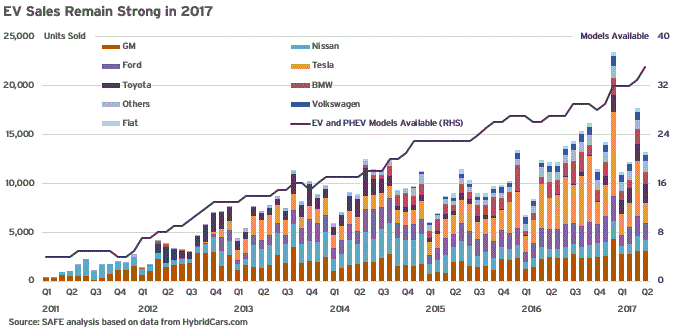EV Sales Remain Robust In U.S., Boom In Europe
by Matt Piotrowski | May 10, 2017
Gasoline prices are mostly flat versus last year and total auto sales have so far been weaker than expected in 2017, but EV purchases are still taking off.
- SHARE
- TWEET
Electric vehicle and plug-in hybrid sales had a good month once again in April, building off of a strong first quarter. EV sales totaled 14,335 units in April, up 9.3 percent year-on-year, with Kia, Hyundai, GM, Nissan, Toyota, and Daimler seeing major increases. With the large number of new models hitting the market this year, 2017 looks to smash records.
A combination of federal and state subsidies, aggressive marketing by carmakers like Tesla, and lower battery costs has supported sales. According to Sweden-based consultancy EV Volumes, EV and plug-in sales in the U.S. should grow by about 60 percent in 2017, supported in particular by deliveries of Tesla’s Model 3 during the fourth quarter. The new Nissan Leaf, to debut in September, could also have a big impact on numbers later this year.
Some 40 new models of electric and plug-in hybrids are set to hit the market this year. “We want to be price-neutral for the consumer,” Steve Kosowski, long-range strategy manager for Kia Motors America, told the New York Times for a story entitled “2017 Could Prove to Be a Turning Point for Plug-In Hybrids.” He added: “When you walk into the showroom, it should be, why wouldn’t you buy this one?” His company’s Kia Niro, a plug-in hybrid, has an affordable price of $23,000 before incentives.
During the first quarter of 2017, registrations of EVs in the EU jumped by almost 30 percent versus the same time last year, with total alternative fuel vehicles up almost 38 percent.
Across the pond, the number of consumers buying EVs has soared. During the first quarter of 2017, registrations of EVs in the EU jumped by almost 30 percent versus the same time last year, with total alternative fuel vehicles up almost 38 percent. That is in stark contrast to the paltry 1.2 percent increase in Q4 and 4.1 percent rise throughout all of 2016. According to the European Automobile Manufacturers Association, total EV registrations reached 47,196 throughout Europe, up almost 11,000 year-on-year, while new hybrid electric vehicles were up by a smashing 61 percent.
European consumers had previously shied away from EVs amid high sticker prices and worries over driving range, but that is changing fast as European governments have provided financial incentives for buying EVs and upped investments in charging infrastructure.
Spain and Germany saw the sharpest gains in alternative fuel vehicles in Europe, with the UK, France, and Italy the next three. “There’s been broad engagement in Germany,” Roland Irle, co-founder and developer at EV Volumes, told The Fuse. “Germany is shaping up to be one of the biggest markets in the world because of government incentives, more electric models, and more charging stations. Carmakers are trying to establish credibility in this space and that is gaining traction among consumers. Suddenly, there is a lot of buzz and everyone is talking EVs.”
Bloomberg reports that sales are in large part due to European automakers such as Volkswagen, which is targeting 1 million sales globally by 2025, BMW, and Daimler increasing the number of EVs to sell in order to meet European emissions rules and to move away from diesel after the VW scandal. Many European consumers had previously shied away from EVs as a result of high sticker prices and worries over driving range, but that is changing fast as European governments have provided financial incentives for buying EVs and upped investments in charging infrastructure.
- Forums
- ASX - By Stock
- Latest Lithium Related Articles
EV Sales Remain Robust In U.S., Boom In Europe by Matt...
Featured News
Add GXY (ASX) to my watchlist
Currently unlisted public company.
The Watchlist
ACW
ACTINOGEN MEDICAL LIMITED
Will Souter, CFO
Will Souter
CFO
Previous Video
Next Video
SPONSORED BY The Market Online











